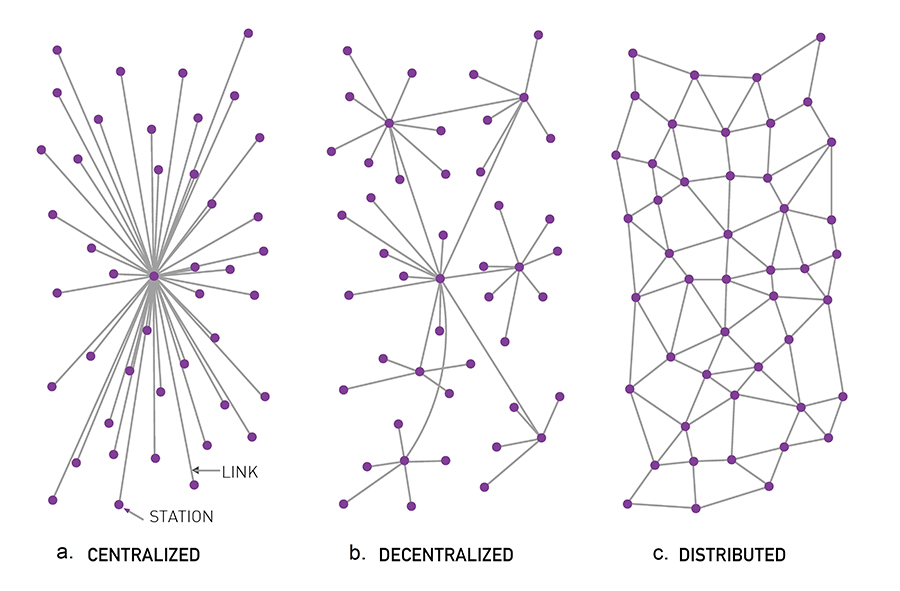The value of decentralization is in empowering people to act decisively within their social contexts

See also: inevitability of centralization
3 Axes of Decentralizatiaon
- Architectural Decentralization: how many physical computers is a system made of? how many computers can fail before the network fails?
- Political Decentralization: how many individuals/organizations ultimately control the computers that the system is made up of?
- Logical Decentralization: are the data structures used to represent the system more monolithic or swarm-like? If you cut the system in half (both providers and users), will both halves continue to fully operate as independent units?
Notes:
- Architectural centralization often leads to political centralization (at least in the physical world, less true for digital spaces), this happened with Bitcoin and Ethereum mining
Centralization
Source: Why Decentralization Matters by Chris Dixon
Most things follow a predictable life cycle along the S-shaped adoption curve.
At the beginning, will do everything they can to garner usage and appear more valuable as platforms with multi-sided positive network effects. However, when they move up the S-curve, their power grows. Eventually, the relationships turn from positive sum to zero sum. Thus, to continue growing, they must extract from users (e.g. selling user data, taxing profits, etc.)
Centralized systems often start out fully baked, but only get better at the rate at which employees at the sponsoring company improve them. Decentralized systems start out half-baked but, under the right conditions, grow exponentially as they attract new contributors.
Types of Centralization
- Proprietary Centralization: creation of a protocol/application with a fixed role for a specific party (e.g. making a protocol for streaming on Zoom). Generally undesirable as it most often reflect commercial goals (strong desire to capture financial benefits by “locking in” users to a proprietary service)
- Beneficial Centralization: need for a single, globally coordinated “source of truth” (e.g. DNS). Need for coordination in establishing p2p connections (endpoint mutual discovery typically requires a third party)
- Inherited Centralization: depending on a centralized “lower-layer” protocol. Having only a single implementation of a protocol is also an inherited centralization risk because applications that use it are vulnerable to the control it has over their operation (can still happen with open source! maintaining forks for example is costly)
- Platform Centralization: platform for centralization — while the protocol itself is not centralized, it facilitates the creation of centralized services and applications (can help to mitigate this through federation)
Standards efforts should focus on providing concrete utility to the majority of their users as published, rather than being a “framework” where interoperability is not immediately available.
Why Decentralize?
- Fault tolerance, less likely to fail accidentally because they rely on many separate redundant components
- Attack resistance, no central point to attack
- Collusion resistance
Decentralization as Activism
Source: Resistant protocols: How decentralization evolves by John Backus
Decentralization doesn’t work in a vacuum, mainstream decentralized systems require a degree of activism to keep the system working
“BitTorrent seems to represent the minimum viable decentralization required to stay alive as defined by the law at the time”
Decentralization is a tactic for diffusing risk for many and lowering the risk for the activists that operate the most sensitive parts of the system. Over applying decentralization isn’t a strategy unless your goal is obscurity
Counterpoints
Faul Tolerance
Common mode failure, all pieces can fail for the same reason. (e.g. all nodes in a blockchain run the same software but that software has a bug)
To counteract this,
- have multiple competing implementations
- knowledge of technical considerations behind underlying protocol must be public and democratized
- core stakeholders should be from multiple companies/orgs or just multiple volunteers
- use proof of stake to move away from hardware centralization risk
Attack Resistance
From a purely mathematical and game theory perspective, decentralization may not even matter. In a finality reversion (e.g. 51% attack), a huge loss of say $50M is still $50M regardless of whether you have validators in 1 org or 10.
However, after considering coercion, decentralization becomes much more important. It’s much harder to threaten 100 people than 1.
Collusion Resistance
Collusion is “coordination that we don’t like”
Consensus model relies on uncoordinated choice model, the assumption that the game consists of many small actors that make decisions independently
90% of the entire Bitcoin network’s mining power can show up at the same conference (as 7 men). Yet, some coordination is good (e.g. strong community spirit and banding together to implement patches and fix bugs)
Ways to counteract:
- Find a happy medium that allows enough coordination for a protocol to move forward but not enough to enable attacks
- Try to make a distinction between beneficial coordination and collusion and make the former easier and the latter harder
Related: decentralization on the Internet